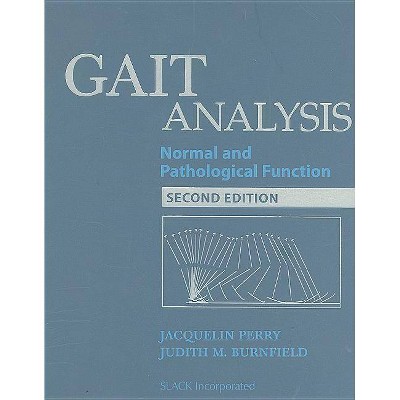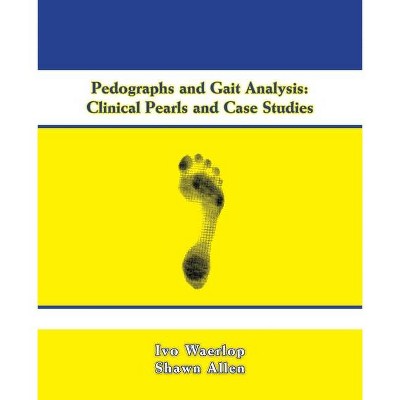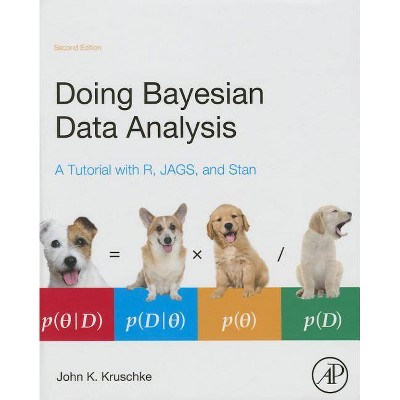Gait Analysis - 2nd Edition by Jacquelin Perry & Judith Burnfield (Hardcover)

Similar Products
Products of same category from the store
AllProduct info
<p/><br></br><p><b> Book Synopsis </b></p></br></br><p>The extensive and ground-breaking work of Dr. Jacquelin Perry is encompassed and detailed in the world renowned text, <i><b>Gait Analysis: Normal and Pathological Function</b></i>. The medical, healthcare, and rehabilitation professions key text for over 18 years on gait....</p><p>Now available in a much anticipated <i><b>New Second Edition</b></i></p><p>Dr. Jacquelin Perry is joined by Dr. Judith Burnfield to present today's latest research findings on human gait. <i><b>Gait Analysis, Second Edition </b></i>has been updated and expanded to focus on current research, more sophisticated methods, and the latest equipment available to analyze gait.</p><p><b>What is New: </b><br>- A new chapter covering running<br>- Synergy of motion between the two limbs<br>- A new chapter covering pediatrics <br>- A new chapter covering stair negotiation<br>- New and updated clinical examples<br>- A section on power inside each chapter covering normal gait<br>- New methods and equipment to analyze gait</p><p><br>This <i><b>Second Edition </b></i>to <i><b>Gait Analysis </b></i>offers a re-organization of the chapters and presentation of material in a more user-friendly, yet comprehensive format. Essential information is provided describing gait functions, and clinical examples to identify and interpret gait deviations. Learning is further reinforced with images and photographs.</p><p><b>Features</b>: <br>- Six sections cover the fundamentals, normal gait, pathological gait, clinical considerations, advanced locomotor functions, and gait analysis systems<br>- Clinical significance of the most common pathological gait patterns<br>- Over 470 illustrations and photographs, as well as 40 tables<br>- Patient examples to illustrate elements of normal and pathological gait</p><p>Tens of thousands of orthopedic, orthotic and prosthetic, physical therapy, and other rehabilitation professionals have kept a copy of <b><i>Gait Analysis </i></b>by their side for over 18 years...join the thousands more who will bring the <i><b>Second Edition </b></i>into their clinics, classrooms, and personal collections.</p><p> </p><p/><br></br><p><b> Review Quotes </b></p></br></br><br>"...in summary, this <i>second edition</i> includes several excellent additions to a classic textbook which should be on the book shelf of ever postgraduate student studying human gait, and every physiotherapist with a specific interest in gait analysis." <p/>- Marietta van der Linden, <i>Physiotherapy</i><br><br>"<i>Gait Analysis: Normal and Pathological Function</i> is a comprehensive text for basic gait analysis, systematically covering the fundamental components of normal and pathological gait. The clinical focus of this text makes it a useful resource for clinicians and students of all levels." <p/>-- Dr. Vivienne Chuter, University of Newcastle, New South Wales, Australia, <i>Physical Therapy Reviews</i><br><br>"The greatest strength of the new edition lies in its logical, reorganized content presentation, which seamlessly interweaves the old and new into a single comprehensive text the practitioner will find valuable in both its breadth and currency. As with the first edition, this textbook will remain a staple in the educational setting for both student and teacher alike. If an O&P student needed one book on gait, this would be that book. For practitioners, the textbook is a ready reference that can augment existing knowledge and inform clinical practice." <p/>-- Bryan Malas, MHPE, CO, <i>American Academy of Orthotists & Prosthetists</i><br><br>"Their excellent and subtle changes have enhanced the book's value, both as a primer and as an encyclopedic reference on gait. The authors allude to what the observer "sees." New methods of gait analysis have more accurately characterized various parts of the gait cycle. Chapter 9 is really a summary chapter of the first part of the book, which covers normal gait. Valuably, it sums up the parts and puts them together. This chapter integrates the total limb function at each phase of gait, elevating observation to a more sophisticated understanding. The use of clinical photographs continues and helps readers relate the illustrated point to a patient or series of patients being treated- an especially valuable feature. The chapters on kinetics, running, and stride are updated and valuable. The chapter on dynamic EMGs has been expanded to discuss the relation of muscle control to the various aspects of gait, both normal and abnormal--an essential concept. Reading the first part of <i>Gait Analysis: Normal and Pathological Function</i> will add dimension to observing gait and will be ideal for providing readers having an advanced interest with a more complete and clear technical understanding. In either instance, reading this text and comprehending the data make this text clinically pragmatic and worthwhile." <p/>- <i>Alfred D. Grant, MD</i>, NYU Hospital for Joint Diseases, New York, NY, JAMA<br><br>"This is a first-class publication on a very important subject not discussed as commonly as other issues in orthopedics. The authors are well-known experts and the book is the result of vast clinical and research experience. This is the best book available on gait analysis." <p/>- Riad Barmada, MD, <i>University of Illinois at Chicago College of Medicine, Doody Enterprises, Inc</i>.<br><br>"This textbook will remain a staple in the educational setting for both student and teacher. If an O&P student needs one book on gait, this is that book. For practitioners, the textbook is a ready reference that can augment existing knowledge and inform clinical practice." <p/>-- Bryan Malas, MHPE, CO<br><p/><br></br><p><b> About the Author </b></p></br></br>J<i>acquelin Perry, MD's </i>interest in gait began in college (UCLA). A major in physical education (1935-1940) introduced her to anatomy and provided a strong background in kinesiology with application to sports. Part of this experience was her attendance at the Physical Therapy Clinic of the Los Angeles Children's Hospital where she began her exposure to disability. Subsequently, she became a physical therapist (Walter Reed Army Hospital, 1941), which expanded her knowledge of anatomy, kinesiology, and disability. Her physical therapy experience in Army hospitals during World War II provided a broad clinical experience (1941-1945). In addition to working with a regular flow of trauma patients, she spent 2 years at a center that had Army programs for poliomyelitis and rheumatoid arthritis. All 3 clinical areas involved a great deal of informal observational gait analysis as one sought to improve the patient's ability to walk. During most of this time, she was also an instructor at two of the Army schools of physical therapy (Hot Springs, AR and Denver, CO). There she taught anatomy, kinesiology, and therapeutic exercise as well as the modalities. Both normal and disabled gait were strong elements of this program. After the war ended, she used her GI bill to go to medical school (UC San Francisco, 1946-1950) for the specific purpose of becoming an orthopaedic surgeon. Dr. Perry's residency in orthopaedic surgery (UCSF, 1951-1955) occurred during the period when poliomyelitis and reconstructive surgery were strong clinical programs. Observational gait analysis and experience in correcting disabled gait became daily practice. <p/>Her next move was to join the staff of the Rancho Los Amigos National Rehabilitation Center. In 1955, poliomyelitis was the entire focus of the rehabilitation program. Disability of lower limbs, spine, and arms were all major concerns while bracing and reconstructive surgery received equal emphasis. Working with this program further expanded her knowledge of muscle function and gait disability. In addition, her experience in observing polio survivors exposed her to a number of different gait patterns as the type of paralysis resulting from this disease varies from patient to patient. Following introduction of the Salk vaccine, polio was conquered so Dr. Perry and her colleagues redirected their attention to other types of chronic impairments. This change was the beginning of their intensive rehabilitation program for spinal cord injury, hemiplegia, arthritis, and children's disorders (primarily muscular dystrophy, myelodysplasia and cerebral palsy). Later, amputee and problem back services were added. At first, the program was for general rehabilitation. Then as the patient groups became large, they formed separate clinical categories with a ward for each (1961). While continuing the polio spine surgery program, Dr. Perry also developed a stroke unit. <p/>Responsibility for persons disabled by a stroke forced her to expand her analysis process, as the functional pathology of individuals with hemiplegia is much more complex than that of polio. Because the standard clinical examination findings correlated poorly with the gait dysfunctions, a system of observational gait analysis was initiated. Developed in conjunction with a group of knowledgeable and dedicated physical therapists, the Rancho Los Amigos Observational Gait Analysis System became highly organized. For the first time, there was a means of cataloging the multiple dysfunctions that occur with the various types of pathology. For the past 25 plus years, they have taught this program nationwide. The organizational background of this book is based on this program. <p/>A second development was the gait laboratory (1968). Its initial purpose was to document the improvement from reconstructive surgery in patients who could not be returned to normal function based on traditional rehabilitation therapy. This system was designed to help ascertain whether surgery actually was the better alternative for these patients. Out of this beginning was developed a functional diagnostic system to be used for planning the reconstructive surgery of patients with spasticity. The emphasis of the program was, and still is, kinesiological electromyography because the primary disability of patients with spasticity is inappropriate muscle action (errors in timing and intensity). Footswitches were developed to define the patient's stride characteristics, and an electrogoniometer to record joint motion during gait also was developed. Clinical service and research have had equal emphasis from the beginning. Another novel emphasis has been on energy cost analysis of walking. An outdoor court was designed where habitual gait could be studied (Dr. Robert Waters spearheaded this). Today, the Pathokinesiology Laboratory at Rancho Los Amigos National Rehabilitation Center is fully equipped with automated motion analysis (CODA(TM)), force plates and walking aids instrumented with force transducers. All types of disability have been studied over the years and continue to be seen as the clinical need increases (cerebral palsy, hemiplegia, spinal cord injury, post polio, arthritis, joint replacement, amputees, myelodysplasia, and muscular dystrophy). <p/>During her career, Dr. Perry has received numerous awards for her pioneering work in many areas of gait and orthopaedics. She received the Kappa Delta Award (Orthopedic Research Society, 1976) for landmark work with dynamic electromyography to define muscle function in cerebral palsy and the Isabelle and Leonard H. Goldson Award in Technology (United Cerebral Palsy Research and Education Foundation, 1981). She was a Shands Lecturer (American Orthopaedic Association, 1988) and received the Shands Award (Orthopaedic Research Society, 1999). Dr. Perry received Lifetime Achievement Awards from the Gait and Clinical Movement Analysis Society (2000) and The Scoliosis Research Society (2008). In December of 2008, the University of Southern California dedicated the Jacquelin Perry Musculoskeletal Biomechanics Laboratory in her honor. Dr. Perry continues her lifelong dedication to the research and clinical application of gait. This publication encompasses the extensive work of Dr. Perry and her successful years as a therapist and a surgeon renowned for her expertise in human gait. <br><i><br>Judith M. Burnfield, PhD, PT </i>is a most welcome co-author. She has excellent analytical skills and has an outstanding command of words. In addition, her scientific preparation and professional experience give her a unique perspective of impaired gait. <p/>Dr. Burnfield's interest in gait began during a clinical internship in 1986 on the Arthritis Service at Rancho Los Amigos National Rehabilitation Center (Rancho). The analytic process encouraged during weekly gait sessions (many led by Dr. Perry) tapped into her investigative nature. Following graduation from the Physical Therapy Program at the State University of New York at Buffalo (1986), Dr. Burnfield accepted a position at Rancho Los Amigos National Rehabilitation Center. Her initial work on the Ortho-Diabetes Service further sparked her passion for understanding gait. Differentiating the influence of human impairments from prosthetic alignment factors was essential for improving patient's walking ability and helped her develop a greater appreciation for the role alignment, forces, and moments have on walking performance. During this period, Dr. Burnfield started teaching a course on prosthetics and orthotics in the Physical Therapist Assistant Program at Cerritos College (Norwalk, CA). Gait was a central component of the course. <p/>Subsequent work on the Stroke Service, Gerontology Service, and in the Polio Clinic at Rancho expanded her knowledge related to the profound impact of weakness on movement disorders. It also highlighted the body's exquisite versatility to compensate when sensation and control mechanisms remained intact (eg, with polio). Dr. Burnfield developed a strong appreciation for the role of lower extremity orthoses in promoting independence, particularly when the device's capabilities were systematically matched to each patient's unique impairments. During this period, Dr. Burnfield engaged in formal training to become a Rancho Gait Instructor. She then led gait sessions at Rancho and started teaching workshops around the country for therapists and physicians. <p/>In 1996, Dr. Burnfield left her position as Director of Physical Therapy at Rancho to commence graduate studies in Biokinesiology at the University of Southern California (USC). Her doctoral research, under the advisement of Dr. Christopher Powers, focused on human and environmental factors contributing to slips and falls during walking. She co-developed and taught the introductory and then advanced observational gait analysis courses for students enrolled in the clinical doctorate of physical therapy program at USC. At the time of her enrollment in USC's Biokinesiology program, she also pursued a position as a research physical therapist working in the Pathokinesiology Laboratory at Rancho due to her desire to enhance her clinical research skills related to normal and pathologic gait. Her work in the latter environment focused on clinical and research studies quantifying gait abnormalities through the analysis of kinematic (motion), kinetic (moment) and electromyographic (muscle activity) data. The unique research and teaching experiences in the two environments complimented each other well and provided a framework for her role instructing Biomechanics and subsequently Kinesiology in the Physical Therapy Program at Mount St. Mary's College in Los Angeles. <p/>Following completion of her doctoral studies, Dr. Burnfield engaged in a postdoctoral fellowship with Dr. Jacquelin Perry. This mentorship had a profound influence on Dr. Burnfield's professional development for which she is most grateful. This focused period of inquiry provided a strong foundation for their subsequent collaboration on the second edition of this book. <p/>In October 2004, Dr. Burnfield joined Madonna Rehabilitation Hospital in Lincoln, Nebraska. She serves as Director of the Institute for Rehabilitation Science and Engineering, Director of the Movement and Neurosciences Center and the Clifton Chair in Physical Therapy and Movement Sciences. Dr. Burnfield has developed a dynamic research laboratory that capitalizes on the close proximity of patients and clinicians, a strong network of research collaborators internally as well as from universities and industry, and a diverse group of undergraduate and graduate students willing and eager to learn and contribute. Research efforts focus on developing and studying new treatments and technologies to help individuals with physical disabilities walk, exercise, and live more independently. The fully instrumented Chapin Gait and Motion Laboratory within the Movement and Neurosciences Center includes state-of-the art technology and software for conducting biomechanical and physiological analyses of movement function including a twelve-camera infrared motion analysis system, 16-channel and 10-channel portable electromyography technology, four force platforms, a footswitch system and plantar pressure mapping technology, and a 30-meter walkway with an overhead safety support track and full-body harness system. <p/>Dr. Burnfield holds adjunct faculty appointments at Creighton University, University of Nebraska- Lincoln, University of Nebraska Medical Center, and the University of Southern California. In addition to a vigorous research agenda, Dr. Burnfield continues to teach gait in the academic setting and presents both nationally and internationally on gait and rehabilitation related topics.
Price History
Price Archive shows prices from various stores, lets you see history and find the cheapest. There is no actual sale on the website. For all support, inquiry and suggestion messagescommunication@pricearchive.us




















